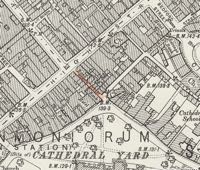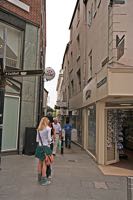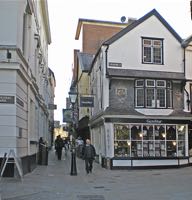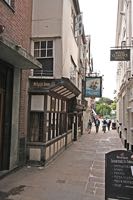
Martins Lane
Once known as Fyshe Street and Luxury Lane
Page updated 24th October 20016
Martins Lane runs from the High Street into Cathedral Close–it has also been known as Luxury Lane and Fyshe Street.
St Martin's Gate was sited at the Close end of the lane. The gate, one of seven around the Close, was built in 1283. The outline of a vaulted arch from the gate can still be seen on the side of the shop on the corner of Martin's Lane and Catherine Street. A post marks the gate on the opposite side. The gate was removed in August 1820 on condition that the lane was to "be made a flat pavement for foot passengers only".
Archeologists discovered that in the 15th Century, the lane consisted of a row of open fronted shuttered shops. Apart from the Ship, there were other traders in the lane including Mr Samuel Porter, who in 1830, carried on his trade of upholsterer. It was also the home of the only kid glove manufacturer in Devonshire during 1860, when W Adams sold gloves from 1s a pair. There were also silversmiths and sellers of Irish linen in the street. In 1768, Mr Tothill agent for the Cathedral Chapter warned the landlord at the Ship Inn in Martin's Lane, to cease throwing ashes and other rubbish in or near the churchyard or face prosecution.
Guy Fawkes was always a lively affair in the 19th Century, centring on Cathedral Yard. A riot occurred in 1847, when an attempt was made, by an unruly mob, to roll a tar barrel down Martin's Lane. A policeman named Ellis was knocked across the blazing barrel, suffered a blow on the back of his head, fell to the ground, and the barrel rolled across his injured body. Edward Fenwick was arrested for assaulting the police, found guilty and fined 5s.
A street lamp in Martins Lane, was lit by oil in the 16th Century. In 1817, the street became the first to be lit by gas. In 1874, the Council considered, widening Martin's Lane and creating a new street behind St Martin's Church joining Catherine Street with Southernhay, to improve access to the east of the city. In the event, Bedford Street was widened.
The Ship Inn, is a popular destination for those visiting the historic parts of the city. The modern Martins Lane is narrow, and from the right view point, charming–from the High Street, none of the buildings are of particular interest. There are only three buildings that have real historic value, and they are the Ship Inn, the timber frame shop on the corner of Martins Lane and Catherine Street and the Clarence Hotel opposite. The Clarence dates back to 1769 when it opened as the Exeter Bank. It is a pity, because this little street could be more like Gandy Street with the right tenants, and had the planners said no to the shop less blocks to the north end of the street.
Sources: The Cathedral Archives, The British Newspaper Archive.
│ Top of Page │




